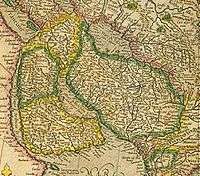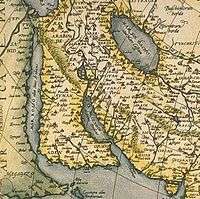Persian Gulf naming dispute
The Persian Gulf naming dispute is concerned with the name of the body of water known historically and internationally as the Persian Gulf (Persian: خلیج فارس), after the land of Persia (the Western exonym for Iran). This name has become contested by some Arab countries since the 1960s[1] in connection with the emergence of pan-Arabism and Arab nationalism, resulting in the invention of the toponym "Arabian Gulf" (Arabic: الخليج العربي) as well as "Gulf", which are terms still used in some Arab countries,[2][3][4]
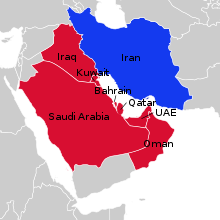
Overview
On almost all maps printed before 1960, and in most modern international treaties, documents and maps, this body of water is known by the name "Persian Gulf" (see #Persian Gulf or equivalent). This reflects traditional usage since the Greek geographers Strabo and Ptolemy, and the geopolitical realities of the time with a powerful Persian Empire comprising the whole northern coastline and a scattering of local authorities on the Arabian Peninsular coast of the Persian Gulf.[5] It was referred to as the Persian Gulf by all Arab historians and geographers, including the Arab Christian writer Agapius, writing in the 10th century.[6] [7]
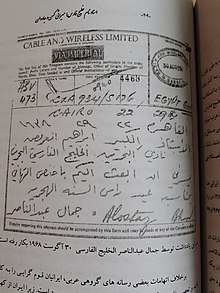
According to authors Philip L. Kohl, Mara Kozelsky, and Nachman Ben-Yehuda in their work Selective Remembrances, Sir Charles Belgrave (British adviser to the ruler of Bahrain) was "the first westerner to use and advocate the name 'Arabian gulf', first in the journal Soat al-Bahrain (Voice of Bahrain) in 1955."[9] Mahan Abedin of The Jamestown Foundation agrees with this, noting that Arab countries used the term "Persian Gulf" until the 1960s.[10][11][12][13] However, with the rise of Arab nationalism during that decade, some Arab countries, including the ones bordering the Gulf, adopted widespread use of the term الخليج العربي (al-Khalīj al-ʻArabī; Arab Gulf or Arabian Gulf) to refer to this waterway. Teymoor Nabili (a senior presenter for Al Jazeera English) said "ironically, among the major drivers of the movement for change were Arab perceptions that Iran, driven by Washington, had supported Israel during the Arab-Israeli war of 1973".[14] This, coupled with the decreasing influence of Iran on the political and economic priorities of the English-speaking Western World, led to increasing acceptance, both in regional politics and the mostly petroleum-related business, of the new alternative naming convention "Arabian Gulf" in Arab countries.
The capture of Baghdad by the Ottoman Empire in 1534 gave Turkey access to the Indian Ocean via the port of Basra at the head of the Persian Gulf. This coincided with the early mapmaking efforts of Gerard Mercator, whose 1541 terrestrial globe attempts to give the most up-to-date information, naming the gulf Sinus Persicus, nunc Mare de Balsera ("Persian Gulf, now Sea of Basra").[15] However, on his world map of 1569, the name is changed to Mare di Mesendin (after the peninsula Ra's Musandam, in modern-day Oman),[16] while his rival Abraham Ortelius, for the world atlas of 1570, opted for Mare El Catif, olim Sinus Persicus (after the Arabian port of Al Qatif), but labelled the entrance to the gulf – the present-day Strait of Hormuz – as Basora Fretum (Strait of Basra).[17] Among all this confusion, the old name gradually reasserted itself in the 17th century, but Turkey still uses the name "Gulf of Basra"[18] in Turkish today.
Following British attempts to control the seaway in the late 1830s, the Times Journal, published in London in 1840, referred to the Persian Gulf as the "Britain Sea", but this name was never used in any other context.[19]
Proposed alternatives
The matter remains very contentious as the competing naming conventions are supported by certain governments in internal literature, but also in dealings with other states and international organizations. Some parties use terms like "The Gulf" or the "Arabo-Persian Gulf". Following the Iranian Revolution of 1979 some people in Islamic groups suggested the use of "Islamic Gulf" or "Muslim Gulf".[20] The originator of the term Islamic Gulf is not known, while some people suggest that prominent figures of the early years of the Islamic republic including Ruhollah Khomeini, Mehdi Bazargan, and Sadegh Khalkhali may have supported the idea. Khalkhali in his May 1979 visit to the UAE suggested the term "Muslim Gulf".[20] The idea was quickly abandoned after Iran was invaded by its predominantly Muslim neighbor, Iraq.
In Arab countries the terms "Gulf" and "Arabian Gulf" are preferred:
The "Gulf" refers to the body of water known as the Arabian Gulf in GCC countries, or the Persian Gulf as referred to in many other places.
— List of GCC countries, Gulf countries, [21]
Viewpoint of Iran (Persia)
Iran only uses the term "Persian Gulf" and does not usually recognize the naming when it is referred to as "Arabian Gulf" or just the "Gulf" or by any other alternative. Iran does not consider the latter an impartial usage, and views it as an active contribution to the abandonment of the historical name.[22]
In a 1974 interview by Mike Wallace in 60 Minutes, the last Shah of Iran himself preferred the term "Persian Gulf" while talking to Wallace.[23] In February 2010 Iran threatened to ban from its airspace foreign airlines, especially those from the Gulf region, who did not use the term "Persian Gulf".[24][25][26][27] In 2011 President Mahmoud Ahmadinejad made a speech to the United Nations General Assembly during which he said that the only correct name of the sea between Iran and the Arabian peninsula was the Persian Gulf, and he dismissed the use of any other names as “illegitimate and void.”[28]
Iran officially designated 30 April as National Persian Gulf Day. The date coincides with the anniversary of Abbas I of Persia's successful military campaign when the Portuguese navy was driven out of the Strait of Hormuz in the Capture of Ormuz (1622). The decision was taken by the High Council of Cultural Revolution, presided over by former President Mohammad Khatami, noting that the campaign launched in 2009 by certain Arab states to rename Persian Gulf was the driver behind the decision.[29][30] The Iranian postal authority has issued a series of stamps commemorating the day.[31][32]
Viewpoint of Arabs
Arab states of the Persian Gulf prefer the use of the term "Arabian Gulf".[34]
Abdel Khaleq al-Janabi, a Saudi Arabian historian, said "It's this name [Persian Gulf] that has been retained by history books and Arab historians, like Ibn Khaldoun and Ibn al Athir. It's also in treaties signed between the governors of the gulf and the British who dominated the region from the beginning of the 20th century ... From a scientific and historical point of view, it has been called the Persian Gulf since Alexander the Great". He said that it was "without foundation" to claim the Romans named it "Arabian Gulf". "Things didn't change until Nasser came to power and the rise of Arab nationalism. The Arabs then began to use the name 'Arabian Gulf'", he added.[35]
In an interview with Al Wasat, Bahraini writer Hussain al-Baharna said one of the reasons for the dispute over naming the "Arabian Gulf as the Persian Gulf" is that the Red Sea was named Arabian Gulf back then, which "prevented the Arabian Gulf from being named as Arabian Gulf, and instead the name Persian Gulf became common".[36] And many prominent scholars and political and religious leaders such as Professor Abdelhadi Tazi, Ahmad al-Saraf, Abdelilah Benkirane (Prime Minister of 2011-2013 Morocco), Abdul Monem Saeed, Abdul Khaliq al-Janabi, Qaradawi, Gen. Majdi Omar, Former First Deputy of the Egyptian National Defense Council in recent decades have commented on the authenticity of the name of the Persian Gulf and the lack of justification for changing the name. [37]

- A historical map of the Persian Gulf in Saeed Al Maktoum House, Dubai, United Arab Emirates. The word "Persian" is erased from the phrase "Persian Gulf".
Viewpoint of third parties
United Nations
According to the book Documents on the Persian Gulf's name (pp 92–98), the United Nations Secretariat and its specialized agencies have requested its staff to use only "Persian Gulf" as a standard geographical designation.
The United Nations Group of Experts on Geographical Names discussed the naming issue during its 23rd session, held in Vienna from 28 March to 4 April 2006. According to the report of the meeting, "It is interesting that from among 6000 existing historical maps published up to 1890, there are only three maps mentioning the names of Basreh Gulf, Ghatif Gulf, and Arabic Gulf, in addition to which the name of small gulfs located at the coast with local utilization can be also named such as Chah Bahar Gulf, Siraf Gulf, Basreh Gulf, Ghatif Gulf, Bahrain Gulf,…. but such names are not applied to the entirety of the Persian Gulf. It is obvious that the promotional use by the Arabs of the three aforementioned maps, whose identity and originality are not clear, in comparison with 6000 maps and more than 200 historical and tourism books from Irastus to Herodotus to Estakhri and Ibn Houghal, who have all called the water body, Persian Gulf, shall lack any value."[38]
The report further notes that "any change, destruction, or alteration of the names registered in historical deeds and maps is like the destruction of ancient works and is considered as an improper action. Therefore, the names of geographical features profiting from a unique historical identity, should not be utilized as political instruments in reaching a political, tribal, and racial objective, or in any clash with national interests and other's values," and finally concludes "...it is worth mentioning that the name of Persian Gulf has been admitted in all the live languages of the world so far and all the countries throughout the world, name this Iranian Sea, just in the language of the people: Persian Gulf. Even Arab brothers do not need to alter a historical name to have a gulf of their own, because there had been a gulf in their own name previously mentioned in the historical and geographical works and drawings, which is called at present the Red Sea (Bahr Ahmar)."[38]
International Hydrographic Organization
The International Hydrographic Organization (IHO), an international body for provision of hydrographic information for worldwide marine navigation and other purposes, uses the name "Gulf of Iran (Persian Gulf)" for this body of water, in its standard S-23 (Limits of Oceans and Seas), section 41, published in 1953.[39]
United States
The United States National Geospatial-Intelligence Agency GEOnet Names Server (GNS) is the "official repository of standard spellings of all foreign place names" sanctioned by the Board of Geographical Names (BGN).[41] The GNS lists "Persian Gulf" as the Conventional name, along with 14 Variant names in different languages, such as "Gulf of Iran", "Gulf of Ajam", "Gulf of Basra", "Arabian Gulf", "Persian-Arabian Gulf", "Gulf of Fars", and "Farsi Gulf".[42]
In Persian Gulf States Country Studies published in 1993 by the Federal Research Division of the U.S. Library of Congress, the authors follow the practise of the BGN by using "Persian Gulf" while acknowledging that the governments of Kuwait, Qatar, United Arab Emirates, Oman and Bahrain "officially reject the use of the term Persian Gulf—as do other Arab governments—and refer to that body of water as the Arabian Gulf".[43]
Since about 1991, due to increased cooperation with Arab states of the Persian Gulf, various branches of the United States armed forces have issued directives to their members to use the "Arabian Gulf" when operating in the area to follow local conventions ("Persian Gulf" is still used in official publications and websites).[44] The practice of the United States Fifth Fleet, based in Bahrain, is to use "Arabian Gulf":
It is commonly understood to be a friendly gesture of solidarity and support for our host nation of Bahrain and our other Gulf Cooperation Council partners in the region to use the term they prefer
— Spokesman for the United States Fifth Fleet, [45]
Atlases and other media
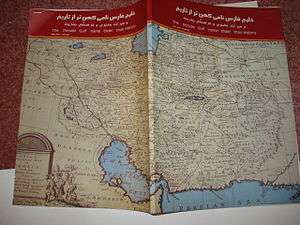
The National Geographic Society uses the name Persian Gulf to refer to this body of water. In 2004, the society published a new edition of its National Geographic Atlas of the World using the term "Arabian Gulf" as an alternative name (in smaller type and in parentheses) for "Persian Gulf". This resulted in heavy protests by many Iranians, especially the Internet user community and the Iranology Academy,[46] which led to the Iranian government acting on the issue and banning the distribution of the society's publications in Iran. On 30 December 2004, the society reversed its decision and published an Atlas Update, removing the parenthetical reference and adding a note: "Historically and most commonly known as the Persian Gulf, this body of water is referred to by some as the Arabian Gulf."[47]
The 2000 AP Stylebook elaborates: Persian Gulf is the "long-established name" and the best choice. "Some Arab nations call it the Arabian Gulf. Use Arabian Gulf only in direct quotations and explain in the text that the body of water is more commonly known as the Persian Gulf."
In 2004, the Persian Gulf-naming dispute was the subject of a Google bomb by an Iranian blogger named Pendar Yousefi.[48][49][50] This was the combined efforts of hundreds of bloggers, webmasters and Persian forums who pointed links with the word Arabian Gulf to a spoof error page found at this link.[50]
Some atlases and media outlets have taken to referring to "The Gulf" without any adjectival qualification. This usage is followed by the BBC and The Times Atlas of the World. Iran does not consider this an impartial usage and views it as an active contribution to abandonment of the historical name. In June 2006, Iran banned the sale of The Economist for the above reason, after a map in the magazine labeled the Persian Gulf as "The Gulf".[51] The magazine repeated this act in its 18 February 2010 article titled "Iraq, Iran and the Politics of Oil: Crude Diplomacy". It also used the name "Arabian Gulf" in the same article.
Google had previously put both Persian Gulf and Arabian Gulf on its Google Maps. After May 2012, it removed both names from the body of water stating that it does not name every place in the world and that it did not want to take a political stance. Iranians complained about the change and started a Twitter campaign asking "Where's the Persian Gulf?".[52] Google Earth continues to show both names, unless viewed through a server from a Gulf Coast Arab country, in which case it labels it simply "Arabian Gulf."
Sporting bodies
A planned second Islamic Solidarity Games in Iran, originally scheduled to take place in October 2009, and later rescheduled for April 2010, was canceled when the Arab World and Iran could not agree over the use of the term "Persian Gulf" in logos and medals for the Games.[53][54]
In association football, the top tier of the Iranian football league system was named the Persian Gulf Cup in August 2006 to promote the Persian naming.[55] The Iran national football team does not take part in the Arabian Gulf Cup for national teams surrounding the waters.[56]
The top football league in the United Arab Emirates (UAE) was founded in 1973 as the UAE Football League. In 2007, the name was changed to UAE Pro-League. Starting from the 2013–14 season the name was changed to UAE Arabian Gulf League, as well as their League Cup and Super Cup competitions.[57] The name change has been viewed as a revival of the Persian Gulf naming dispute[58] with Iran accusing the United Arab Emirates of racism,[59][60] and the Football Federation of the Islamic Republic of Iran barring the transfer of Javad Nekounam to a UAE club.[61] Similarly, the Arab Gulf Cup Football Federation was founded in 2016 for the Arab states of the Persian Gulf.
Gallery
Persian Gulf or equivalent
- Basora-Persian Sea
 Map of Persia,Mecran
Map of Persia,Mecran Heinrich. MARE ERYTHRAEUM 1903
Heinrich. MARE ERYTHRAEUM 1903 Soulier, E.; Andriveau-Goujon, MER ERYTHREE 1838
Soulier, E.; Andriveau-Goujon, MER ERYTHREE 1838_Empire_1747.jpg) Persian(IRAN) Empire 1747
Persian(IRAN) Empire 1747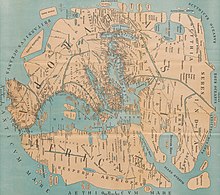 An Early world map by Pomponius Mela 43 AD. Red Sea named Arabian Sea and Persian Gulf and Oman Sea named Persian Sea.
An Early world map by Pomponius Mela 43 AD. Red Sea named Arabian Sea and Persian Gulf and Oman Sea named Persian Sea.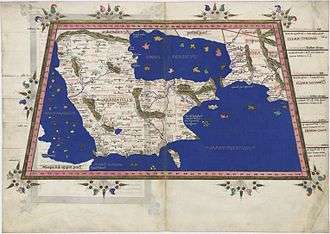 Map VI from Ptolemy's "Cosmographia" showing Sinus Persicus (Persian Gulf) and Sinus Arabicus (Red Sea), reconstruction from 1467
Map VI from Ptolemy's "Cosmographia" showing Sinus Persicus (Persian Gulf) and Sinus Arabicus (Red Sea), reconstruction from 1467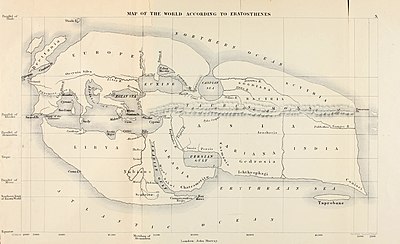 19th Century reconstruction of 194 BC Eratosthenes' map, Denoting Persian Gulf
19th Century reconstruction of 194 BC Eratosthenes' map, Denoting Persian Gulf Map of 1531 denoting Sinus Persicus.
Map of 1531 denoting Sinus Persicus.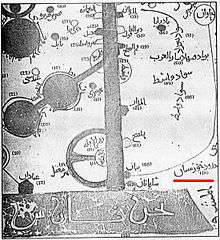 Regional map showing the word Bahr Fars, ("Persian Sea") in Arabic, from the 9th century text Al-aqalim by the Persian geographer Istakhri
Regional map showing the word Bahr Fars, ("Persian Sea") in Arabic, from the 9th century text Al-aqalim by the Persian geographer Istakhri Giacomo Gastaldi's map circa 1548 is denoted by cartographic historian Gerald Tibbetts as the first "modern" map of the area, denoting Golpho de Persia
Giacomo Gastaldi's map circa 1548 is denoted by cartographic historian Gerald Tibbetts as the first "modern" map of the area, denoting Golpho de Persia French map dated 1740 denoting Golfe de Perse.
French map dated 1740 denoting Golfe de Perse.- An 1808 British map depicting the "Persian Gulf".
.jpg) 1893 Ottoman map calling it "Khaleej Al-Ajam"
1893 Ottoman map calling it "Khaleej Al-Ajam" A Saudi ARAMCO map from 1952 using the term "Persian Gulf" (الخليج الفارسي).
A Saudi ARAMCO map from 1952 using the term "Persian Gulf" (الخليج الفارسي). Altkolorierte Kupferstich-Karte. v. Willem Janszoon Blaeu.
Altkolorierte Kupferstich-Karte. v. Willem Janszoon Blaeu.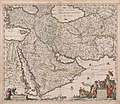 This very important map uses Persian gulf and elcatif for this gulf and Arabian gulf for the red sea and shows that elcatif doesn't mean Arabian gulf. Jacob van Merus, 1680, Amesterdam
This very important map uses Persian gulf and elcatif for this gulf and Arabian gulf for the red sea and shows that elcatif doesn't mean Arabian gulf. Jacob van Merus, 1680, Amesterdam Regno di Persia con le notitie delle ... Publication Date 1679 Scarce map extending from the Eufrate to the Indo.Showing major rivers, mountains and cities. From Il Mercurio Geografico, printed by De Rossi
Regno di Persia con le notitie delle ... Publication Date 1679 Scarce map extending from the Eufrate to the Indo.Showing major rivers, mountains and cities. From Il Mercurio Geografico, printed by De Rossi Perse Turquie Asiatique et Arabie old map Desnos 1766
Perse Turquie Asiatique et Arabie old map Desnos 1766 Persian Gulf antique map La Perse Bellin 1764
Persian Gulf antique map La Perse Bellin 1764 Caucasus Old Map Royame de Perse Georgie Bonne 1780.
Caucasus Old Map Royame de Perse Georgie Bonne 1780. Persia Sive Sophorum regnum Old map Persia Merian 1638
Persia Sive Sophorum regnum Old map Persia Merian 1638 Amsterdam / 1640 circa by Jansson
Amsterdam / 1640 circa by Jansson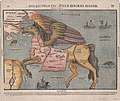 map of Asia in the shape of the mythical winged horse Pegasus. Print in 1581 Hannover by Henrich Bunting
map of Asia in the shape of the mythical winged horse Pegasus. Print in 1581 Hannover by Henrich Bunting Map of 1732 Asia issued by French cartographer Guillaume Danet
Map of 1732 Asia issued by French cartographer Guillaume Danet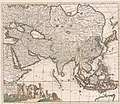 Amsterdam / 1685 (1700 ca) First issued by Justus Danckerts, this example is done by his son "T[heodorus] Danckerts,"
Amsterdam / 1685 (1700 ca) First issued by Justus Danckerts, this example is done by his son "T[heodorus] Danckerts,"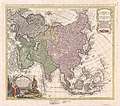 Nuremberg / 1744 Colored By Religions Detailed map of Asia, based upon Johann Mattheus Haas' stereographical projection of the world.
Nuremberg / 1744 Colored By Religions Detailed map of Asia, based upon Johann Mattheus Haas' stereographical projection of the world. important Jodocus Hondius corrected mistake of using "Arabian Gulf" for two different regions and updated map of Asia. Published in Amsterdam 1620 Ca
important Jodocus Hondius corrected mistake of using "Arabian Gulf" for two different regions and updated map of Asia. Published in Amsterdam 1620 Ca Published in Amsterdam by Nicholas Visscher the Elder.1670.
Published in Amsterdam by Nicholas Visscher the Elder.1670.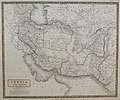 A.K. Johnston -1850-Edinburg
A.K. Johnston -1850-Edinburg D'Anville- 1788, Published by L. Harrison in England
D'Anville- 1788, Published by L. Harrison in England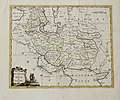 George Rollos, 1770 published in london
George Rollos, 1770 published in london George Rollos 1770 London
George Rollos 1770 London Guillaume de L'Isle - 1731- Paris
Guillaume de L'Isle - 1731- Paris J. Rapkin, Published by Tallis.-1851-london
J. Rapkin, Published by Tallis.-1851-london Jan Huighen van Linschoten, Henricus Florent Langren- 1596-Amsterdam
Jan Huighen van Linschoten, Henricus Florent Langren- 1596-Amsterdam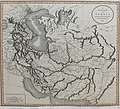 John Cary- London -1801.jpg
John Cary- London -1801.jpg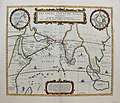 Location of Persian gulf and Arabian gulf by Janssonius, Joannes- 1640-Amsterdam
Location of Persian gulf and Arabian gulf by Janssonius, Joannes- 1640-Amsterdam Mercator, Belgium, 1578
Mercator, Belgium, 1578 P. Santini- 1779-Venice
P. Santini- 1779-Venice Published by D'Apres de Mannevillette-1775-paris.jpg
Published by D'Apres de Mannevillette-1775-paris.jpg Robert- 1760- Paris.jpg
Robert- 1760- Paris.jpg The London Geographical Institute 1890, Published by George Philip & Son.jpg
The London Geographical Institute 1890, Published by George Philip & Son.jpg V. Levasseur - Paris- 1838.jpg
V. Levasseur - Paris- 1838.jpg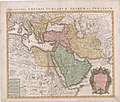 Amsterdam J. Covens et C. Mortier,1720.jpg
Amsterdam J. Covens et C. Mortier,1720.jpg_Fries.jpg) Strasbourg 1525 by Lorenz (Laurent) Fries.jpg
Strasbourg 1525 by Lorenz (Laurent) Fries.jpg Rigobert Bonne- 1771 Paris.jpg
Rigobert Bonne- 1771 Paris.jpg Published by Pieter van der Aa-Leiden-1713
Published by Pieter van der Aa-Leiden-1713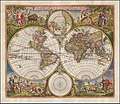 Published by Frederick De Wit- Amsterdam-1680 ca
Published by Frederick De Wit- Amsterdam-1680 ca Published by Sebastian Münster-Basle-1542
Published by Sebastian Münster-Basle-1542 Die beyden Halbkugeln-Vienna-1790
Die beyden Halbkugeln-Vienna-1790 Mappemonde a l'usage du Roy Par Guillaume Delisle Premier-Geographe de S.M. . . . 1720 (Shows De Gama Land)
Mappemonde a l'usage du Roy Par Guillaume Delisle Premier-Geographe de S.M. . . . 1720 (Shows De Gama Land)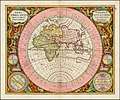 Hemisphaerium Orbis Antiqui Cumzonis Circulis et Situ Populorum Diverso-Amsterdam- 1660 (1708)
Hemisphaerium Orbis Antiqui Cumzonis Circulis et Situ Populorum Diverso-Amsterdam- 1660 (1708) The World Agreeable to the latest Discoveries-London- 1754
The World Agreeable to the latest Discoveries-London- 1754 Mappe Monde Carte Universelle de la Terre Dressee Sur les Relations les plus nouvelles, Soumises aux Obseravtions Astronomiques-Paris-1755
Mappe Monde Carte Universelle de la Terre Dressee Sur les Relations les plus nouvelles, Soumises aux Obseravtions Astronomiques-Paris-1755 Persia, Caspian Sea, done by ye Czar, and Part of Independent Tartary With His Tract from Astracan in Gilan in Persia Above 2700 English MIles
Persia, Caspian Sea, done by ye Czar, and Part of Independent Tartary With His Tract from Astracan in Gilan in Persia Above 2700 English MIles Middle East Antique map Babylon Assyriens Philippe 1787
Middle East Antique map Babylon Assyriens Philippe 1787 Persia Kingdom Ormus Strait Hormuz Old plan Bellin 1756
Persia Kingdom Ormus Strait Hormuz Old plan Bellin 1756 Japanese Map of Saudi Arabia-1874-Published by Naito
Japanese Map of Saudi Arabia-1874-Published by Naito Carte De La Turquie De L'Arabie et De La Perse, Dressee sur les Memoires les plus recens rectifiez par les Observations de Mrs. de l'Academie Royule, des Sciences-Amsterdam-1720
Carte De La Turquie De L'Arabie et De La Perse, Dressee sur les Memoires les plus recens rectifiez par les Observations de Mrs. de l'Academie Royule, des Sciences-Amsterdam-1720
Arabian Gulf, Sea of Musandam, Gulf of Basra or Gulf of Qatif
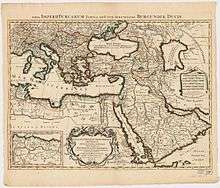
.jpg) One of many maps by Hondius using the term Sinus Arabia
One of many maps by Hondius using the term Sinus Arabia.jpg) 17th century French map "Sein Arabique"
17th century French map "Sein Arabique" 1626 map calling it "Sea of Qatif", or the Arabian Gulf. This map also names the red sea the Arabian gulf
1626 map calling it "Sea of Qatif", or the Arabian Gulf. This map also names the red sea the Arabian gulf Jan Jansson's map, 17th century (MARE ELCATIF formerly SINUS PERSICUS).
Jan Jansson's map, 17th century (MARE ELCATIF formerly SINUS PERSICUS). In this map of 1717, the cartographer Herman Moll used Gulph of Bassora
In this map of 1717, the cartographer Herman Moll used Gulph of Bassora%2C_Persia_and_Arabia_-_Geographicus_-_MagniTurcarum-seutter-1740.jpg)
_1803.jpg) The Ottoman Cedid Atlas of 1803 calling it the Gulf of Basra
The Ottoman Cedid Atlas of 1803 calling it the Gulf of Basra
See also
References
- Eilts, Hermann F. (Autumn 1980). "Security Considerations in the Persian Gulf". International Security. Vol. 5, No. 2. pp. 79–113.
- Documents on the Persian Gulf's name the eternal heritage ancient time by Dr.Mohammad Ajam
- Abedin, Mahan (4 December 2004). "All at Sea over 'the Gulf'". Asia Times Online. Retrieved 13 May 2012.
- Bosworth, C. Edmund (1980). "The Nomenclature of the Persian Gulf". In Cottrell, Alvin J. (ed.). The Persian Gulf States: A General Survey. Baltimore, Maryland: Johns Hopkins University Press. pp. xvii–xxxvi.
Not until the early 1960s does a major new development occur with the adoption by the Arab states bordering on the Gulf of the expression al-Khalij al-Arabi as a weapon in the psychological war with Iran for political influence in the Gulf; but the story of these events belongs to a subsequent chapter on modern political and diplomatic history of the Gulf. (p. xxxiii.)
- Spotlight on Regional Affairs. 1–9. 25. Institute of Regional Studies. 2006. pp. 1–2.
Since the 1960s, there has been a dispute over the name of the Persian Gulf, namely, whether in the Arabic language it should be called the ... In possibly every map printed before 1960 and in most modern international treaties, documents and maps, this body of water is known by the name 'Persian Gulf, reflecting traditional usage since the Greek geographers Strabo and Ptolemy, and the geopolitical realities of the time with a powerful Persian ...
- "Agapius on a Boat". roger-pearse.com. Retrieved 24 February 2009.
- Documents on the Persian Gulf's name Dr.Mohammad Ajam
- http://www.irdc.ir/fa/content/12485/print.aspx Archived 4 March 2016 at the Wayback Machine IRDC
- Kohl, Philip L.; Mara Kozelsky; Nachman Ben-Yehuda (2007). Selective Remembrances: Archaeology in the Construction, Commemoration, and Consecration of National Pasts. University of Chicago Press. p. 225. ISBN 978-0-226-45059-9.
- Alai, Cyrus (7 February 2012) [15 December 2000]. "Geography iv. Cartography of Persia". Encyclopædia Iranica. Retrieved 1 February 2012.
After World War II, some circles decided to change the name of the Persian Gulf to Arabian Gulf. Although the government of Persia opposed the move vehemently, in some editions of a few maps and atlases the term Persian was omitted, leaving only 'The Gulf' (e.g., The Times Atlas, p. 39), while the historical term Persian Gulf mostly remained intact, as in the National Geographic Atlas. (p. 77; fig. 7.)
- Milani, Mohsen M. (30 March 2012) [15 December 2006]. "Iraq vi. Pahlavi Period, 1921–79". Encyclopædia Iranica. Retrieved 1 February 2012.
...Iraqi troops began to engage their Iranian counterparts in border skirmishes. Iraq once again called for 'liberation' of the Khuzestan province from 'Persian occupiers,' and began to use the term 'Arabian Gulf,' rather than Persian Gulf....
- "Picture of Gamal Abdel Nasser's Handwritten Letter, Using the Term Persian Gulf". Archived 24 July 2011 at the Wayback Machine
- Picture of 1952 Saudi Arabian ARAMCO map using the name Persian Gulf
- Teymoor Nabili (12 December 2010). "Persian Gulf or Arabian Gulf?". Al Jazeera English. Retrieved 11 June 2012.
- Mercator, Gerard. "Terrestrial Globe, Arabian Section" (1541) via Harvard University.
- Mercator, Gerard. "Mercator Projection World Map" (1569) via wilhelmkruecken.de.
- Ortelius, Abraham. "Map of Turkish Empire" Archived 3 March 2012 at the Wayback Machine (1570) via cartographicarts.com.
- Republic of Turkey Ministry of Culture and Tourism history page. www.kultur.gov.tr.
- United Nations Group of Experts on Geographical Names "Historical, Geographical and Legal Validity of the Name 'Persian Gulf'". (April 2006).
- Jubin M. Goodarzi (2006). Syria and Iran: Diplomatic Alliance and Power Politics in the Middle East. I.B.Tauris. pp. 29, 297. ISBN 978-1-84511-127-4. Retrieved 3 November 2014.
- "DubaiFAQs UAE information guide". DubaiFAQs UAE information guide. Retrieved 1 June 2016.
- Staff (24 January 2008). "Name Game Stokes U.S.–Iranian Tensions". CNN. Retrieved 15 June 2012.
- Shah of Persia (February 1974). "60 Minutes" (Interview). Interviewed by Mike Wallace. CBS.
- "No Operation". Presstv.com. Archived from the original on 2 March 2010. Retrieved 6 December 2013.
- Spencer, Richard (23 February 2010). "Iran Threatens Flight Ban over 'Persian' Gulf Name Row". The Daily Telegraph. Retrieved 22 May 2010.
- "Iran: Airlines Must Say 'Persian Gulf' Or Face Airspace Ban". Huffingtonpost.com. 22 February 2010. Retrieved 6 December 2013.
- "Iran To Arabs: It's 'Persian Gulf' Not 'Arabian Gulf' – If You Call It 'Arabian Gulf', You're Toast". Business Insider. 22 February 2010. Retrieved 6 December 2013.
- "Iran (Islamic Republic of) H.E. Mr. Mahmoud Ahmadinejad, President". UN General Assembly General Debate of the 66th Session. Retrieved 4 May 2016.
- "Iran Names Persian Gulf National Day" Archived 1 June 2010 at the Wayback Machine. Retrieved 26 February 2009.
- "Iranians To Observe Persian Gulf Day". Tehran Times. Retrieved 30 April 2010.
- -persian-gulf-national-day-in-foreign-ministry https://japan.mfa.gov.ir/en/newsview/536033 -persian-gulf-national-day-in-foreign-ministry Check
|url=value (help). Retrieved 5 February 2012. Missing or empty|title=(help). Islamic Republic of Iran Broadcasting. - Persian Gulf stamps, Retrieved 26 February 2009.
- Gamal Abdel Nasser (20 July 1959). "Where I Stand and Why". LIFE. Vol. 47 no. 3. p. 98.
- Henderson, Simon (Spring 2004). "Understanding the Gulf States". The Washington Institute. Retrieved 1 June 2016.
- "Web wrangle: Persian or Arabian Gulf?". France 24. 16 June 2010. Retrieved 11 June 2012.
- (in Arabic) Ali Najeeb (19 June 2008). "البحرين بين الاستقلال وتبعيتها لفارس". Al Wasat. Retrieved 12 June 2012.
- Documents on the Persian Gulf's name the eternal heritage ancient time.
- Historical, Geographical and Legal Validity of the Name: PERSIAN GULF. Working Paper No. 61, United Nations Group of Experts on Geographical Names, United Nations. New York, 2006..
- "Limits of Oceans and Seas, 3rd Edition" (PDF). International Hydrographic Organization. 1953. p. 21. Archived from the original (PDF) on 8 October 2011. Retrieved 11 June 2013.
- «President Obama’s Nowruz Message to the Iranian People Archived 30 July 2016 at the Wayback Machine» at White House official website Retrieved: August 4, 2016. website.
- "NGA: GNS Home". Earth-info.nga.mil. 16 September 2013. Retrieved 5 February 2014.
- "Archived copy". Archived from the original on 7 October 2007. Retrieved 17 January 2007.CS1 maint: archived copy as title (link).
- "Persian Gulf States Country Studies" (PDF). American Memory from the Library of Congress. Retrieved 2 June 2016.
- "Navy Causes Controversy by Changing 'Persian Gulf' to 'Arabian Gulf'". AllGov.com. 9 December 2010.
- Zraick, Karen. "Persian (or Arabian) Gulf Is Caught in the Middle of Regional Rivalries". New York Times. Retrieved 2 June 2016.
- "Iranologists condemn deliberate distortion of Persian Gulf's name". Payvand. 24 December 2004. Retrieved 6 August 2013.
- . National Geographic.
- Petrossian, Fred (10 May 2007). "Interview with Pendar Yousefi: Blogger, Designer and Google Bomber". Global Voices Online. Retrieved 14 May 2012.
- Legofish :: Google Bomb Archived 19 February 2009 at the Wayback Machine.
- "The Persian Gulf – The Arabian Gulf Google Bomb" Archived 20 February 2010 at the Wayback Machine.
- "Louvre's 'Gulf' Move Draws Iranian Ire". Radio Free Europe/Radio Liberty. 2006. Retrieved 18 December 2008.
- Sebastian Usher (4 May 2012). "Google Map's missing Gulf angers Iranians". BBC. Retrieved 29 June 2012.
- Ap, Riyadh (17 January 2010). "Islamic Solidarity Games Cancelled after Gulf Row Divides Nations". Associated Press (via The Guardian). Retrieved 18 January 2010.
- Staff (18 January 2010). "Islamic Solidarity Games Cancelled over Gulf Dispute". BBC News. Retrieved 15 June 2012..
- Montague, James (2008). When Friday Comes: Football in the War Zone. Mainstream Publishing. p. 57. ISBN 978-1-84596-369-9.
- Montague, James (2008). When Friday Comes: Football in the War Zone. Mainstream Publishing. p. 113. ISBN 978-1-84596-369-9.
- "New League name announced by H.E. Mohammed Thani Murshed Al Romaithi". Pro League Committee. 26 May 2013. Retrieved 26 May 2013.
- James M. Dorsey (13 September 2011). "MIDEAST — Gulf rivalry between Iran, UAE transfered [sic] to the football pitch". Hurriyetdailynews.com. Retrieved 23 September 2013.
- Category: Asia (29 May 2013). "Iran accuses UAE of racism in renaming Pro League to the Arabian Gulf League". Inside World Football. Retrieved 23 September 2013.
- persiangulfstudies.com. "Persian Gulf Studies Center". Persiangulfstudies.com. Retrieved 23 September 2013.
- "Iran bars captain's UAE transfer over Gulf name". Fox News. Retrieved 23 September 2013.
External links
- "Historical, Geographical and Legal Validity of the name: Persian Gulf", Iranian delegation working paper for the 23rd Session of the United Nations Group of Experts on Geographical Names, April 2006
- "The Persian Gulf" and international organisations
- Documents on the Persian Gulf's name the eternal heritage ancient time,by Dr.M.Ajam,ISBN 978-600-90231-4-1
- PERSIAN GULF IN ANTIQUITY (archived from the original on 2007-04-04), Encyclopedia Iranica
- Factsheet on the Legal and Historical Usage of the "Persian Gulf" – ISG MIT
- A repository of Historical maps
- cultural heritage.15/04/2002
- Iran bans The Economist over map
- ISNA: "Goods labelled with "Arabian Gulf" banned in Iran."
- Documents on the Persian Gulf
- 32 historical map of Persian Gulf
- Occasional Paper of MEI The Persian Gulf: Validity of the Name Issue No. 22 -Monday, 29 November 2010
- What’s in a name? the Persian Gulf The New York Times:
- Persian Gulf: From rich history to security depth
- Statement On Persian Gulf/Arabian Gulf
